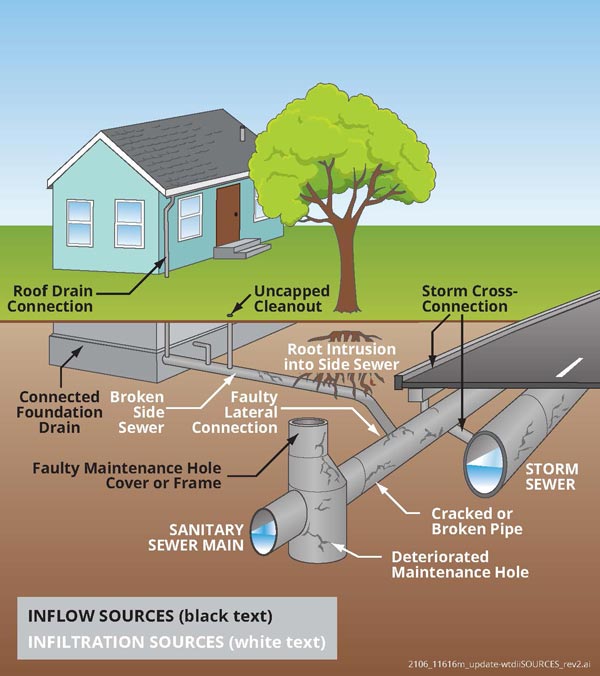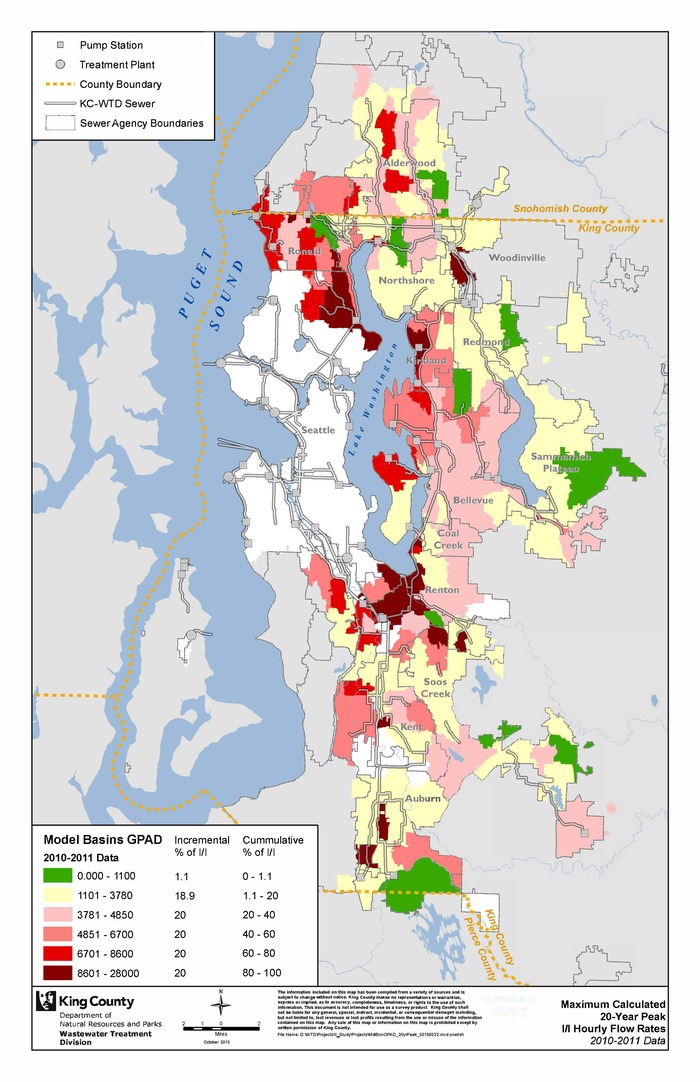Resources for local sewer agencies
Find I/I resources for local sewer agencies such as a side sewer maintenance mailer and best management practices toolkit and additional brochures, fact sheets, graphics, and maps.
Side Sewer Maintenance Mailer (2022)
The Side Sewer Maintenance Mailer was developed by King County for MWPAAC agencies to distribute to their residents. The educational mailer describes components of a side sewer, private property source disconnection, and side sewer maintenance best practices. The mailer is available in English as well as the following languages:
- Spanish
- Chinese – Simplified
- Chinese – Traditional
- Vietnamese
- Somali
- Russian
- Korean
- Ukrainian
- Tagalog
- Amharic
- Arabic
Side Sewer Best Management Practices Toolkit (2021)
The Side Sewer Best Management Practices (BMP) Toolkit was developed for MWPAAC agencies and includes a description, instructions to local sewer agencies, example website landing page content, and example content (that can be branded by local sewer agencies) for four BMPs:
- Unauthorized connection prohibition
- Courtesy notice to property owner/occupant regarding roots in side sewer connections
- Side sewer maintenance guidance document
- Private property I/I source disconnection/redirection public education materials
Note: This toolkit is Appendix A from the Final Regional Best Management Practices Development, December 2021, under Reports/Evaluation of I/I Reduction Concepts to Improve the Regional I/I Program (2017–2021).
Reports
Phase 1 - These technical memos explore concepts to reduce I/I programmatically and with a focus on private side sewers. Concepts include region-wide side sewer standards and inspection training, interagency coordination to identify and manage I/I, side sewer inspection and repair programs, and side sewer grant/loan programs. This planning phase resulted in three programs being recommended by MWPAAC for further definition and consideration.
- Final Verify 2004 King County Final Draft Regional I/I Control Standards, Procedures and Policies, October 2017
- Final Assessment of Existing Local Agency Sewer and Side Sewer Standards, October 2017
- Final Approach to Achieve Common Sewer and Side Sewer/Lateral Standards, February 2019
- Final Evaluation of Current Inspection Programs at Cities and Sewer Districts, October 2017
- Final Outline for a Standardized Regional Inspection Training Program, February 2019
- Final Private Side Sewer Program Identification and Relevance to the King County Wastewater Service Area, April 2019
- Final Private Side Sewer Program Evaluation Process, April 2019
Phase 2 – These technical memos further define three program options recommended in Phase 1 including,
- Regional sewer and side sewer standards,
- A regional inspector training and certification program, and
- A private side sewer inspection program with financial assistance.
This planning process resulted in the definition of two programs options. The regional best management practices were recommended by MWPAAC for implementation by component agencies while the inspector training and certification program was not recommended for implementation at this time. Work on the third program, private side sewer inspection program with financial assistance, was not completed because the program is being considered as part of broader sewer system planning effort.
- Final Regional Best Management Practices Development, December 2021
- Final Inspector Training and Certification Program Development, December 2021
This report summarizes the history of the project, the work performed, follow-up investigations, and findings about the project’s effectiveness in reducing I/I. It describes lessons learned from the project that can be applied to similar work in the future and outlines additional steps needed in order to use the project results for future decision-making.
Skyway Infiltration and Inflow Reduction Demonstration Project Evaluation Report (13.6 MB)
This report presents recommendations for projects to reduce infiltration and inflow (I/I) in portions of King County's regional wastewater conveyance system. Reducing I/I, which consists of stormwater and groundwater entering a sanitary sewer system from various sources, makes more capacity available for sewage in the county's wastewater system. This increased capacity helps prevent overflows and reduce the need for capital projects to add system capacity. King County is engaged in a long-term program to reduce I/I when cost effective to do so, and the projects outlined in this alternatives analysis represent an early test of the effectiveness of I/I reduction measures over a large area.
Initial Infiltration and Inflow Reduction Project Alternatives Analysis Report and Appendices (88 MB)
Initial Infiltration and Inflow Reduction Project Alternatives Analysis Report, no appendices (60 MB)
This report lists the Executive's recommendations for both I/I reduction and long-term I/I control and for program administration and policy. In addition to cost-effectively removing enough I/I from the collection system to delay, reduce, or eliminate some otherwise needed conveyance system improvement (CSI) projects, measures must be in place to maintain I/I reductions long-term and to prevent future increases in I/I throughout the regional system. Long-term I/I control includes policy, administrative, financial, and technical measures that promote an ongoing program of review, maintenance, and repair of the collection and conveyance system.
Transmittal letter from Executive Ron Sims to the King County Council (276KB)
Executive's Recommended Regional Infiltration and Inflow Control Program Report and Appendices (4.6MB)
As part of its Regional Needs Assessment, King County developed a list of conveyance system improvement (CSI) projects. These projects will help accommodate the increasing wastewater flows brought about by growth. To make the most effective use its resources, the County evaluated whether it is cost effective to eliminate or delay projects on the CSI Project List by reducing the amount of I/I in the conveyance system. The benefit/cost analysis compared the estimated costs of constructing conveyance system improvement projects with the estimated costs of I/I reduction projects.
Benefit/Cost Analysis Report (4.8MB)
Appendices (Available on CD upon request)
- Appendix A1 - Select List Cost-Effectiveness Analysis Package per MWPAAC E&P Planning Assumptions
- Appendix A2 - Regional Cost Effectiveness Analysis Package per MWPAAC E&P Planning Assumptions
- Appendix A3 - 30-Percent I/I Removal Cost Effectiveness Package per MWPAAC E&P Planning Assumptions
- Appendix B1 - Sensitivity Analysis Select List-Cost Effectiveness Analysis Packages per Initial Planning Assumptions
Alternatives/Options Report (2.3MB)
The Regional Needs Assessment (RNA) identified conveyance system improvement (CSI) projects and costs in order to provide a baseline for conducting benefit/cost analyses of potential infiltration and inflow reduction projects
Regional Needs Assessment Report and Appendices (2.2MB)
The report gives an overview of the I/I control program, the experiences gained from the pilot projects, and detailed information on project selection, design, construction, costs, and results. The information in the report is technical. Its purpose is not only to record what was done but also to serve as the basis for additional studies on the costs and benefits of I/I control measures.
Pilot Project Report (10.4 MB)
- Pilot Project Report Executive Summary (1 MB)
- Pilot Project Report Appendices (21.4 MB)
- Warranty Inspection (888KB), August 2006—Supplement to the Pilot Project Report
2001/2002 Wet Weather Flow Monitoring Technical Memorandum (8.9 MB)
Appendices available on CD upon request
2000/2001 Wet Weather Flow Monitoring Technical Memorandum (8.9 MB)
Appendices available on CD upon request
The Operational Master Plan, or OMP, explains how King County will implement the Regional Wastewater Services Plan as required by Ordinance 13680, which adopts changes to King County's Comprehensive Water Pollution Abatement Plan.
The ordinance focuses on the policies that drive the RWSP.
RWSP Operational Master Plan (413 KB)
Ordinance 13680 (121 KB)
See also: RWSP Master Plan
Additional materials
Sewer System Inspection Information Fact Sheet
| Storm Water & Ground Water in Sewers: A Regional Problem | Nov 2010 |
| Sewer System Inspection Information Fact Sheet | Jun 2008 |
Maps of the maximum calculated 20-year peak infiltration and inflow hourly flow rates in the King County system. The data for the following three maps are based on flow monitoring conducted in 2000/2001 and 2001/2002, documented in the Wet Weather Flow Monitoring technical memorandums.
|
Jan 2004 |
|
|
Jan 2004 |
|
| Jan 2004 |
The data for the following map is based on flow monitoring conducted in 2009/2010 and 2010-2011.

 Translate
Translate

